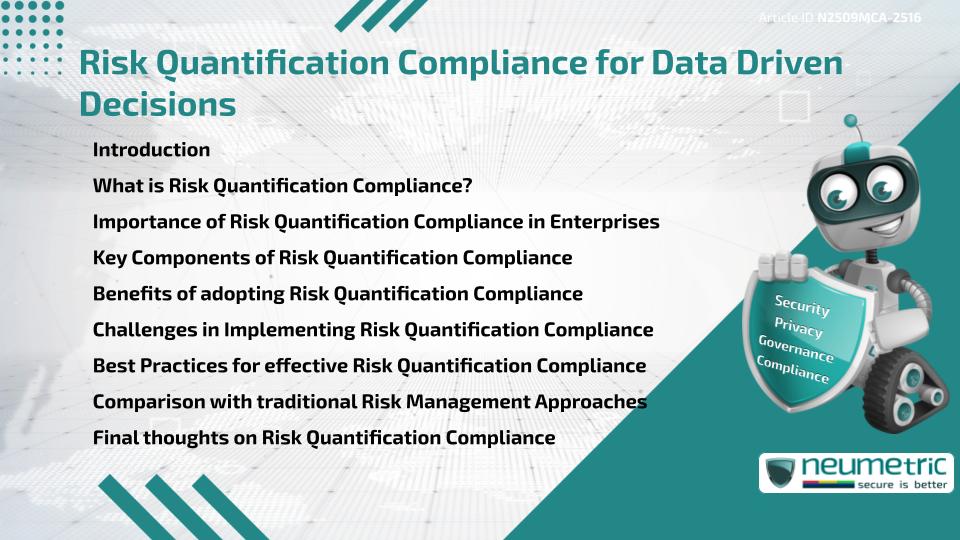Table of Contents
ToggleIntroduction
Risk Quantification Compliance is becoming essential for enterprises that rely on data driven decisions. It ensures that Risk Assessments are not only performed consistently but also aligned with Regulatory Standards & Business Objectives. By translating Risks into measurable values, Organisations can prioritise Threats, allocate resources more effectively & build Accountability. This article explains what Risk Quantification Compliance means, why it matters, its key components, benefits, challenges, Best Practices & how it compares with traditional Risk Management.
What is Risk Quantification Compliance?
Risk Quantification Compliance refers to the practice of measuring, evaluating & documenting Risks using standardised methods that meet Regulatory & Organisational requirements. Instead of treating Risks qualitatively, it emphasises numerical Scoring, Probability Assessments & Financial impact modeling.
Much like converting abstract academic grades into measurable grade point averages, Risk Quantification Compliance provides clear metrics that help Stakeholders understand the true scale of Vulnerabilities & their consequences.
Importance of Risk Quantification Compliance in Enterprises
Enterprises face a variety of Risks ranging from cyberattacks & regulatory fines to supply chain disruptions. Traditional methods often rely on subjective assessments, which can lead to inconsistent results. Risk Quantification Compliance ensures that:
- Risks are evaluated consistently across departments
- Regulatory & Industry requirements are met
- Business leaders have measurable data to guide decisions
- Investments in Risk Mitigation are justifiable & transparent
By quantifying Risks, Organisations can better compare trade-offs, much like investors balance portfolios by weighing potential returns against measurable Risks.
Key Components of Risk Quantification Compliance
Successful implementation involves several interconnected components:
- Standardised frameworks: Use of models like Factor Analysis of Information Risk [FAIR] or ISO 27005.
- Data-driven modeling: Leveraging historical data, Threat Intelligence & simulations.
- Probability & impact scoring: Assigning numerical values to Likelihood & severity.
- Compliance mapping: Aligning quantified Risks with regulatory frameworks such as GDPR, HIPAA or SOX.
- Reporting & dashboards: Presenting results in formats understandable to both executives & auditors.
Benefits of adopting Risk Quantification Compliance
Enterprises gain several advantages by embedding Risk Quantification Compliance into their Governance & operations:
- Clarity: Translates abstract Risks into measurable values.
- Efficiency: Enables smarter allocation of budgets & resources.
- Accountability: Provides Audit-ready documentation of Risk decisions.
- Alignment: Connects Risk Management with strategic goals.
- Resilience: Strengthens preparedness by identifying the most critical Vulnerabilities.
Challenges in Implementing Risk Quantification Compliance
Despite its benefits, Organisations may encounter barriers such as:
- Complexity: Developing accurate models requires expertise & robust data.
- Cultural resistance: Shifting from subjective to quantitative methods may face opposition.
- Data Gaps: Incomplete or unreliable data can skew results.
- High costs: Implementing tools & training can require significant investment.
These challenges underline the importance of balancing technology with human judgment & gradual adoption strategies.
Best Practices for effective Risk Quantification Compliance
To succeed with Risk Quantification Compliance, enterprises should follow structured practices:
- Define clear objectives for quantifying Risks
- Select appropriate frameworks like FAIR or ISO 27005
- Combine quantitative models with expert input
- Continuously update data & assumptions
- Communicate results in business-friendly language for decision-makers
Comparison with traditional Risk Management Approaches
Traditional Risk Management often relies on subjective ratings such as “high”, “medium” or “low”. While simple, this method can be inconsistent & less actionable. Risk Quantification Compliance, on the other hand, assigns measurable values that enable cost-benefit analysis, regulatory reporting & objective prioritisation.
For example, a traditional approach might label a data breach as “high Risk”, while Quantification would show it could cost $5 million in lost revenue & fines, allowing leadership to justify stronger investments in Cybersecurity.
Final thoughts on Risk Quantification Compliance
Risk Quantification Compliance is a powerful approach that transforms subjective evaluations into actionable insights. By aligning Risk measurement with regulatory expectations & business strategies, enterprises can enhance Transparency, Accountability & Resilience. Despite challenges like data complexity & cultural resistance, its benefits in decision-making far outweigh the limitations.
Takeaways
- Risk Quantification Compliance translates Risks into measurable values aligned with regulations.
- Key components include frameworks, modeling, Compliance mapping & reporting.
- Benefits involve Clarity, Accountability, Efficiency & Resilience.
- Challenges include complexity, resistance & data limitations.
- Best Practices emphasise frameworks, expert input & clear communication.
FAQ
What does Risk Quantification Compliance mean?
It refers to measuring Risks numerically using standardised methods that align with regulations & organisational Policies.
Which frameworks support Risk Quantification Compliance?
Commonly used frameworks include Factor Analysis of Information Risk [FAIR] & ISO 27005.
Why is Risk Quantification Compliance better than qualitative methods?
It provides measurable data for decision-making, enabling cost-benefit analysis & regulatory reporting.
What are common challenges with Risk Quantification Compliance?
Challenges include lack of reliable data, complexity of modeling & cultural resistance to change.
Can Small Businesses use Risk Quantification Compliance?
Yes, though they may adopt simplified models, the approach can still improve decision-making & accountability.
How does Risk Quantification Compliance support regulations?
It maps quantified Risks to Legal requirements such as GDPR, HIPAA or SOX, making Audits more efficient.
Need help for Security, Privacy, Governance & VAPT?
Neumetric provides organisations the necessary help to achieve their Cybersecurity, Compliance, Governance, Privacy, Certifications & Pentesting needs.
Organisations & Businesses, specifically those which provide SaaS & AI Solutions in the Fintech, BFSI & other regulated sectors, usually need a Cybersecurity Partner for meeting & maintaining the ongoing Security & Privacy needs & requirements of their Enterprise Clients & Privacy conscious Customers.
SOC 2, ISO 27001, ISO 42001, NIST, HIPAA, HECVAT, EU GDPR are some of the Frameworks that are served by Fusion – a SaaS, multimodular, multitenant, centralised, automated, Cybersecurity & Compliance Management system.
Neumetric also provides Expert Services for technical security which covers VAPT for Web Applications, APIs, iOS & Android Mobile Apps, Security Testing for AWS & other Cloud Environments & Cloud Infrastructure & other similar scopes.
Reach out to us by Email or filling out the Contact Form…


